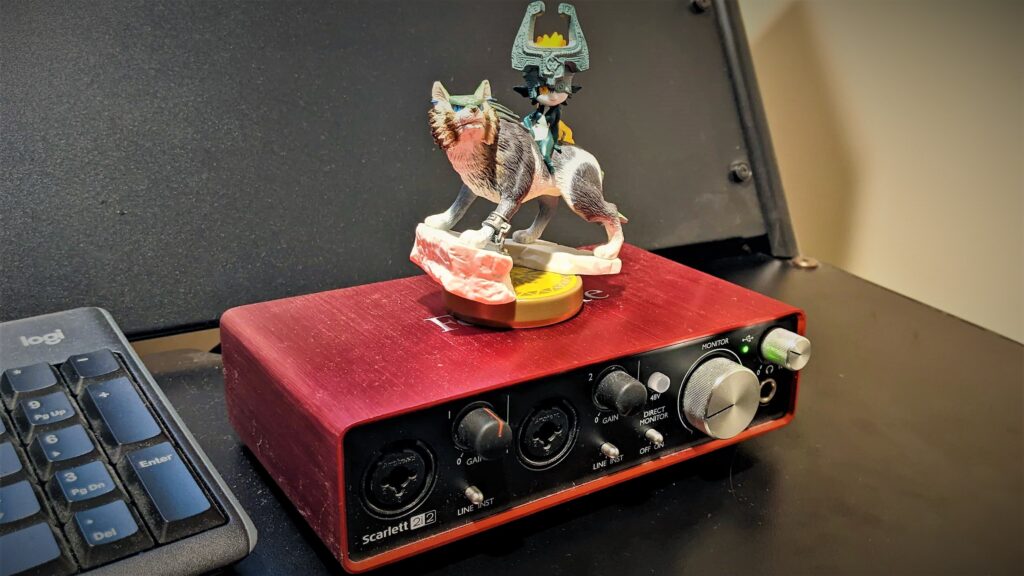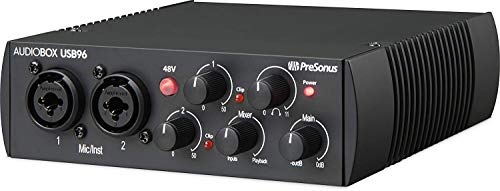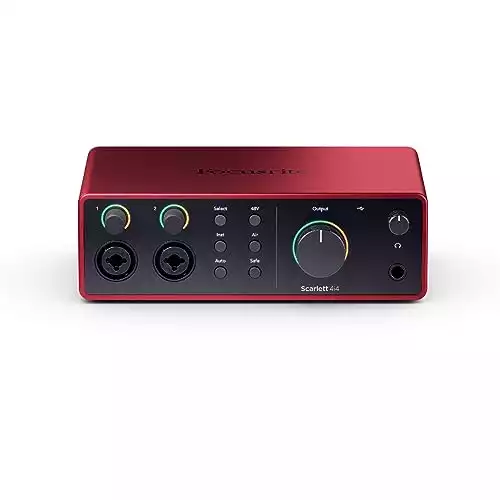We live in a golden age of audio technology. Anyone can record professional-sounding music and podcasts right in their bedroom. (Including you!)
One essential piece of gear is an audio interface, which acts as the bridge between your computer and your audio gear.

What Does an Audio Interface Do?
An audio interface is the hub between your computer and audio equipment. It receives analog audio signals from a microphone or instrument, then converts them into a digital format your computer can use. They also convert digital audio from your computer into analog audio for your speakers and headphones.
Most audio interfaces feature XLR inputs for microphones, along with line outputs and headphone jacks for monitoring audio. Many also have built-in preamps to help boost the input level (gain), and can provide 48V phantom power for microphones that need it.
Types of Audio Interfaces
There are a few major types of audio interfaces to consider. Functionally, they’re mostly the same. But what’s different is the connection type.
Common Types of Audio Interfaces
- USB Audio Interfaces — The most common type of audio interface. Most PCs and smart devices will use this connection type. Older interfaces typically use the standard 2.0 or 3.0 connectors, while more modern devices use USB-C.
- Thunderbolt Audio Interfaces — Best for Mac users. Thunderbolt offers lower latency than USB, meaning there’s little to no delay when recording. The reduced latency also makes it easier to record audio with effects turned on.
- Ethernet Audio Interfaces — Typically found in professional studios. Ethernet offers super-low latency and provides increased scalability. This lets you create complex, multi-room setups and record dozens of inputs at once.
Other Types of Audio Interfaces
- PCI Audio Interfaces — Also made for professional recording studios. These interfaces install directly into the PCI slot on your computer. PCI interfaces don’t include any preamps, XLR, or line inputs. Instead, they work with external consoles and preamps.
- FireWire Audio Interfaces — FireWire is a legacy connection type that’s more or less been replaced by Thunderbolt. Some older computers might use it, and a handful of manufacturers still produce FireWire interfaces.
- MIDI Interfaces — Technically, these aren’t real audio interfaces. MIDI interfaces are made to work with hardware synths, drum machines, controllers, and other MIDI-based modules. Some audio interfaces include 5-pin connectors and double as MIDI interfaces.
The average person reading this will most likely stick with a USB or Thunderbolt devices. That said, you can get professional-sounding results from any type of interface.
Some enthusiasts and professionals will use ethernet devices. Very few people outside of professional settings will ever use a PCI interface.
MIDI interfaces can be incredibly useful for synth enthusiasts who have several instruments in their collection.
Audio Interfaces vs USB Microphones
USB microphones have come a long way. Most creators will only ever need a single microphone for basic recording, streaming, or podcasting. In which case, a simple USB mic will be more than enough.
But if you’re doing more complex or specialized work, then an audio interface is an essential piece of equipment.
Advantages of Audio Interfaces vs USB Mics
Audio interfaces offer some notable advantages over USB microphones:
- Ability to use XLR microphones — Broadly speaking, these mics are generally more powerful than USB microphones. They come in many types and sizes. And in most cases, the audio fidelity is greater.
- Recording more than one track at the same time —Your computer’s sound chip can only record one thing at a time. So using multiple USB mics will confuse it. An audio interface will let you use two or more inputs without issues.
- Recording instruments like guitars and keyboards — Many interfaces have ¼-inch inputs built into them. That means you can plug your guitar or keyboard into the interface and record it directly into the computer.
- More powerful and accurate audio output — Audio interfaces can power external speakers without any problems. Plug some studio monitors into your interface for a big, clear sound that outperforms your computer’s built-in speakers. Headphones also typically sound better through the interface instead of your computer’s phone jack.

What Audio Interface Should You Get?
There’s no shortage of interfaces out in the world. And you can find them in just about any price range. So if you’re a beginner, you won’t need to spend much money.
Beginner-level Audio Interfaces
These audio interfaces are modestly-priced and only come with one or two inputs. Still, they provide excellent audio quality without too many extra frills or features.
If you’re looking for your first audio interface, we have some recommendations.
(Note: These are affiliate links.)
|
$165.00
|
N/A
|
$59.00
|
|
|
|
- 2 mic/line inputs
- Award-winning preamps
- Focusrite’s Air mode
- Bundled software included
- 2 mic/line inputs
- MIDI in/out
- Works with iOS devices
- Bundled with Studio One Artist (DAW)
- 1 mic/line input
- 1 line input
- Small form factor
- For more recommendations, check out our favorite picks for the best beginner audio interfaces.
Advanced Audio Interfaces
Broadly speaking, advanced interfaces will include more inputs, better electronics, and additional features. They might also come with Thunderbolt, Ethernet, or other connection types.
If you’re looking for these advanced features, you can find some reasonably-priced interfaces for under $1000.
|
$998.66
|
$279.99
|
$179.00
|
|
|
|
- Thunderbolt connection
- 2 mic + 1 line inputs
- DUO Core processor
- Built-in talkback mic
- Mac-exclusive software bundle
- 2 mic + 2 line inputs
- MIDI in/out
- Award-winning preamps
- Multiple EQ/Air modes
- Auto-Gain & Clip-Safe modes
- Includes software bundle
- 4 mic/line inputs w/ MIDAS preamps
- 4 additional line inputs
- MIDI in/out
- Up to 9 audio outputs
Studio-Level Audio Interfaces
Professional recording studios have more demanding needs than the typical home musician. For starters, they could have more inputs, more features, and even a rack-mountable form factor.
|
$2,799.00
|
$497.83
|
|
|
- 12 analog inputs
- 18 additional inputs via hardware expansion
- MIDI in/out
- Pristine audio quality
- Total FX Mixer app for iPad
- Optional remote control (sold separately)
- 8 mic/line combo inputs
- 10 additional inputs via hardware expansion
- MIDI in/out
- Up to 20 outputs
- Focusrite's AIR Mode
- Software bundle included
Things to Consider When Buying an Audio Interface
Whether you’re shopping for your first audio interface or getting another for your collection, you should consider a few things before buying one.
Number of Inputs
One of the first things to think about is how many microphones you’re going to use. Think of these recording situations:
- Two or more people for a podcast
- Two or more musicians (like a full band)
- Instrument with vocals
- Recording a single source in stereo
- Setting up additional microphones throughout the room
There are a lot of different audio interfaces that’ll fit your needs. You can pick one as basic as a single-input interface, or one with as many as 12 preamps.
USB, Thunderbolt, or Other Connection Types
Look out for the connection ports your computer or mobile device uses.
Most modern interfaces will connect to your computer via USB cables. So basically, they’ll work with almost any Mac or PC.
Thunderbolt is another common connection type. They’re ideal for Mac computers, and even some iOS devices.
Older devices might use an ethernet cable or another legacy connection type like FireWire and PCI.
MIDI In/Out
Many audio interfaces also include MIDI input and output. The input allows you to connect a MIDI controller to your computer and play software instruments inside your DAW.
The MIDI output allows your computer to transmit MIDI data to another instrument (like a hardware synthesizer) and “play” it.
Sample Rate and Bit Depth
If you’ve done some shopping around, then you’ve probably come across these terms before. Basically, the sampling rate and bit depth refer to the quality of the digital audio signal.
Here’s an oversimplified explanation of what each term means:
- Sample rate is the number of audio samples per second of digital audio (measured in kiloHertz, or kHz).
- Bit depth refers to how big each of those samples can be.
The higher the numbers, the better quality the audio is going to be. The trade-off is that the file sizes will be bigger too.
Some interfaces support audio up to 192 kHz and 24-bit. If you’re going to be doing high-end studio recording, you’ll probably want something that supports 96 kHz or higher.
But most producers will use 24-bit audio set between 44.1 kHz and 96 kHz audio. These settings give you good quality audio with manageable file sizes.
Looking for Interfaces and Gear? Check Out These Resources
We’ve put together a few resources for finding audio interfaces and other audio gear:







